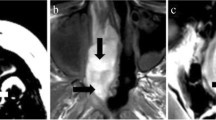Abstract
Purpose
To evaluate the value of texture analysis (TA) of conventional magnetic resonance imaging (MRI) and diffusion-weighted imaging (DWI) in the differential diagnosis between sinonasal non-Hodgkin’s lymphoma (NHL) and squamous cell carcinoma (SCC).
Methods
Forty-two patients with sinonasal SCC and 30 patients with NHL were retrospectively enrolled. TAs were performed on T2-weighted image (T2WI), apparent diffusion coefficient (ADC) and contrast-enhanced T1-weighted image (T1WI). Texture parameters, including mean value, skewness, kurtosis, entropy and uniformity were obtained and compared between sinonasal SCC and NHL groups. Receiver-operating characteristic (ROC) curves and logistic regression analyses were used to evaluate the diagnostic value and identify the independent TA parameters.
Results
The mean value and entropy of ADC, and mean value of contrast-enhanced T1WI were significantly lower in the sinonasal NHL group than those in the SCC group (all P < 0.05). ROC analysis indicated that the entropy of ADC had the best diagnostic performance (AUC 0.832; Sensitivity 0.95; Specificity 0.67; Cutoff value 6.522). Logistic regression analysis showed that the entropy of ADC (P = 0.002, OR = 26.990) was the independent parameter for differentiating sinonasal NHL from SCC.
Conclusion
TA parameters of conventional MRI and DWI, particularly the entropy value of ADC, might be useful in the differentiating diagnosis between sinonasal NHL and SCC.




Similar content being viewed by others
References
Helsel JC, Bardales RH, Mukunyadzi P (2003) Fine-needle aspiration biopsy cytology of malignant neoplasms of the sinonasal tract. Cancer 99:105–112. https://doi.org/10.1002/cncr.10956
Bishop JA (2016) Newly described tumor entities in sinonasal tract pathology. Head Neck Pathol 10:23–31. https://doi.org/10.1007/s12105-016-0688-7
Robbins KT, Ferlito A, Silver CE et al (2011) Contemporary management of sinonasal cancer. Head Neck 33:1352–1365. https://doi.org/10.1002/hed.21515
Chalastras T, Elefteriadou A, Giotakis J et al (2007) Non-Hodgkin’s lymphoma of nasal cavity and paranasal sinuses. A clinicopathological and immunohistochemical study. Acta Otorhinolaryngol Ital 27:6–9
Kawaguchi M, Kato H, Tomita H et al (2017) Imaging characteristics of malignant sinonasal tumors. J Clin Med 6:116. https://doi.org/10.3390/jcm6120116
Kato H, Kanematsu M, Watanabe H, Kawaguchi S, Mizuta K, Aoki M (2015) Differentiation of extranodal non-Hodgkins lymphoma from squamous cell carcinoma of the maxillary sinus: a multimodality imaging approach. Springerplus 4:228. https://doi.org/10.1186/s40064-015-0974-y
Kim SH, Mun SJ, Kim HJ, Kim SL, Kim SD, Cho KS (2018) Differential diagnosis of sinonasal lymphoma and squamous cell carcinoma on CT, MRI, and PET/CT. Otolaryngol Head Neck Surg 159:494–500. https://doi.org/10.1177/0194599818770621
Fujima N, Kameda H, Tsukahara A et al (2015) Diagnostic value of tumor blood flow and its histogram analysis obtained with pCASL to differentiate sinonasal malignant lymphoma from squamous cell carcinoma. Eur J Radiol 84:2187–2193. https://doi.org/10.1016/j.ejrad.2015.07.026
Gencturk M, Ozturk K, Caicedo-Granados E, Li F, Cayci Z (2019) Application of diffusion-weighted MR imaging with ADC measurement for distinguishing between the histopathological types of sinonasal neoplasms. Clin Imaging 55:76–82. https://doi.org/10.1016/j.clinimag.2019.02.004
Su CQ, Zhang X, Pan T et al (2020) Texture analysis of high b value diffusion-weighted imaging for evaluating consistency of pituitary macroadenomas. J Magn Reson Imaging 51:1507–1513. https://doi.org/10.1002/jmri.26941
Fujima N, Homma A, Harada T et al (2019) The utility of MRI histogram and texture analysis for the prediction of histological diagnosis in head and neck malignancies. Cancer Imaging 19:5. https://doi.org/10.1186/s40644-019-0193-9
Nardi C, Tomei M, Pietragalla M et al (2021) Texture analysis in the characterization of parotid salivary gland lesions: a study on MR diffusion weighted imaging. Eur J Radiol 136:109529. https://doi.org/10.1016/j.ejrad.2021.109529
Zou HH, Yu J, Wei Y, Wu JF, Xu Q (2019) Response to neoadjuvant chemoradiotherapy for locally advanced rectum cancer: texture analysis of dynamic contrast-enhanced MRI. J Magn Reson Imaging 49:885–893. https://doi.org/10.1002/jmri.26254
Depeursinge A, Foncubierta-Rodriguez A, Van De Ville D, Müller H (2014) Three-dimensional solid texture analysis in biomedical imaging: review and opportunities. Med Image Anal 18:176–196. https://doi.org/10.1016/j.media.2013.10.005
Lubner MG, Smith AD, Sandrasegaran K, Sahani DV, Pickhardt PJ (2017) CT texture analysis: definitions, applications, biologic correlates, and challenges. Radiographics 37:1483–1503. https://doi.org/10.1148/rg.2017170056
Xu QG, Fu LP, Wang ZC et al (2012) Characteristic findings of malignant melanoma in the sinonasal cavity on magnetic resonance imaging. Chin Med J (Engl) 125:3687–3691
Wang X, Zhang Z, Chen X, Li J, Xian J (2014) Value of magnetic resonance imaging including dynamic contrast-enhanced magnetic resonance imaging in differentiation between inverted papilloma and malignant tumors in the nasal cavity. Chin Med J (Engl) 127:1696–1701
Xiao Z, Tang Z, Zheng C, Luo J, Zhao K, Zhang Z (2020) Diffusion kurtosis imaging and intravoxel incoherent motion in differentiating nasal malignancies. Laryngoscope 130:E727-735. https://doi.org/10.1002/lary.28424
Wang X, Dai S, Wang Q, Chai X, Xian J (2021) Investigation of MRI-based radiomics model in differentiation between sinonasal primary lymphomas and squamous cell carcinomas. Jpn J Radiol 39:755–762. https://doi.org/10.1007/s11604-021-01116-6
Deng Y, Soule E, Samuel A et al (2019) CT texture analysis in the differentiation of major renal cell carcinoma subtypes and correlation with Fuhrman grade. Eur Radiol 29:6922–6929. https://doi.org/10.1007/s00330-019-06260-2
Porter DA, Heidemann RM (2009) High resolution diffusion-weighted imaging using readout-segmented echo-planar imaging, parallel imaging and a two-dimensional navigator-based reacquisition. Magn Reson Med 62:468–475. https://doi.org/10.1002/mrm.22024
Funding
No.
Author information
Authors and Affiliations
Corresponding author
Ethics declarations
Conflict of interest
No.
Additional information
Publisher's Note
Springer Nature remains neutral with regard to jurisdictional claims in published maps and institutional affiliations.
Rights and permissions
About this article
Cite this article
Su, GY., Liu, J., Xu, XQ. et al. Texture analysis of conventional magnetic resonance imaging and diffusion-weighted imaging for distinguishing sinonasal non-Hodgkin’s lymphoma from squamous cell carcinoma. Eur Arch Otorhinolaryngol 279, 5715–5720 (2022). https://doi.org/10.1007/s00405-022-07493-6
Received:
Accepted:
Published:
Issue Date:
DOI: https://doi.org/10.1007/s00405-022-07493-6




